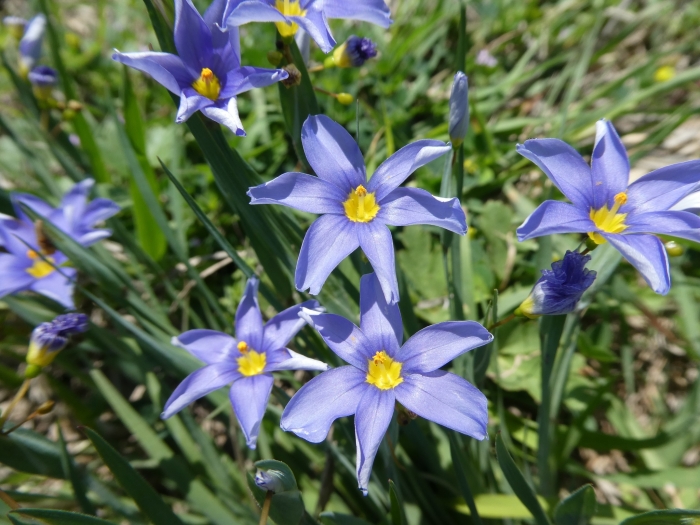Roadside Blue-Eyed Grass
(Sisyrinchium langloisii)
Roadside Blue-Eyed Grass (Sisyrinchium langloisii)
/
/

© Lisa Winnett-Pequeno
CC BY 4.0
Image By:
© Lisa Winnett-Pequeno
Recorded By:
Copyright:
CC BY 4.0
Copyright Notice:
Photo by: © Lisa Winnett-Pequeno | License Type: CC BY 4.0 | License URL: http://creativecommons.org/licenses/by/4.0/ | Uploader: birdsandbugs27 | Publisher: iNaturalist |





















Estimated Native Range
Summary
Sisyrinchium langloisii, commonly known as Roadside Blue-eyed Grass, is a perennial herb native to prairies, open woodlands, and meadows in the southern United States, especially Texas and Louisiana. It typically grows to a height of 6-12 inches (15-30 cm) and forms dense clumps of narrow, grass-like leaves. The plant produces bright blue, star-shaped flowers with yellow centers that bloom profusely in the spring and early summer, adding a splash of color to the landscape. The flowers are quite showy and attract pollinators such as bees and butterflies.
Roadside Blue-eyed Grass is valued for its low maintenance and ease of growth, making it an excellent choice for naturalistic plantings, borders, rock gardens, and as a ground cover in sunny to partly shaded areas. It thrives in moist, well-drained soils but can tolerate periods of drought once established. While it prefers full sun to partial shade, it will bloom less profusely in shadier conditions. This species is not commonly afflicted by serious pests or diseases, but overwatering or poor drainage can lead to root rot. It is not known to be invasive and generally stays within its bounds without aggressive spreading.CC BY-SA 4.0
Roadside Blue-eyed Grass is valued for its low maintenance and ease of growth, making it an excellent choice for naturalistic plantings, borders, rock gardens, and as a ground cover in sunny to partly shaded areas. It thrives in moist, well-drained soils but can tolerate periods of drought once established. While it prefers full sun to partial shade, it will bloom less profusely in shadier conditions. This species is not commonly afflicted by serious pests or diseases, but overwatering or poor drainage can lead to root rot. It is not known to be invasive and generally stays within its bounds without aggressive spreading.CC BY-SA 4.0
Plant Description
- Plant Type: Herb
- Height: 1-2 feet
- Width: 0.5-1 feet
- Growth Rate: Moderate
- Flower Color: Blue, Purple, White, Yellow
- Flowering Season: Spring
- Leaf Retention: Evergreen
Growth Requirements
- Sun: Part Shade
- Water: Medium, High
- Drainage: Fast, Medium, Slow
Common Uses
Bee Garden, Bird Garden, Butterfly Garden, Low Maintenance, Potted Plant
Natural Habitat
Native to prairies, open woodlands, and meadows in the southern United States, particularly Texas and Louisiana
Other Names
Common Names: Wild Blue-Eyed Grass
Scientific Names: , Sisyrinchium langloisii, Sisyrinchium canbyi, Sisyrinchium flaccidum, Sisyrinchium furcatum, Sisyrinchium implicatum, Sisyrinchium tenuifolium,
GBIF Accepted Name: